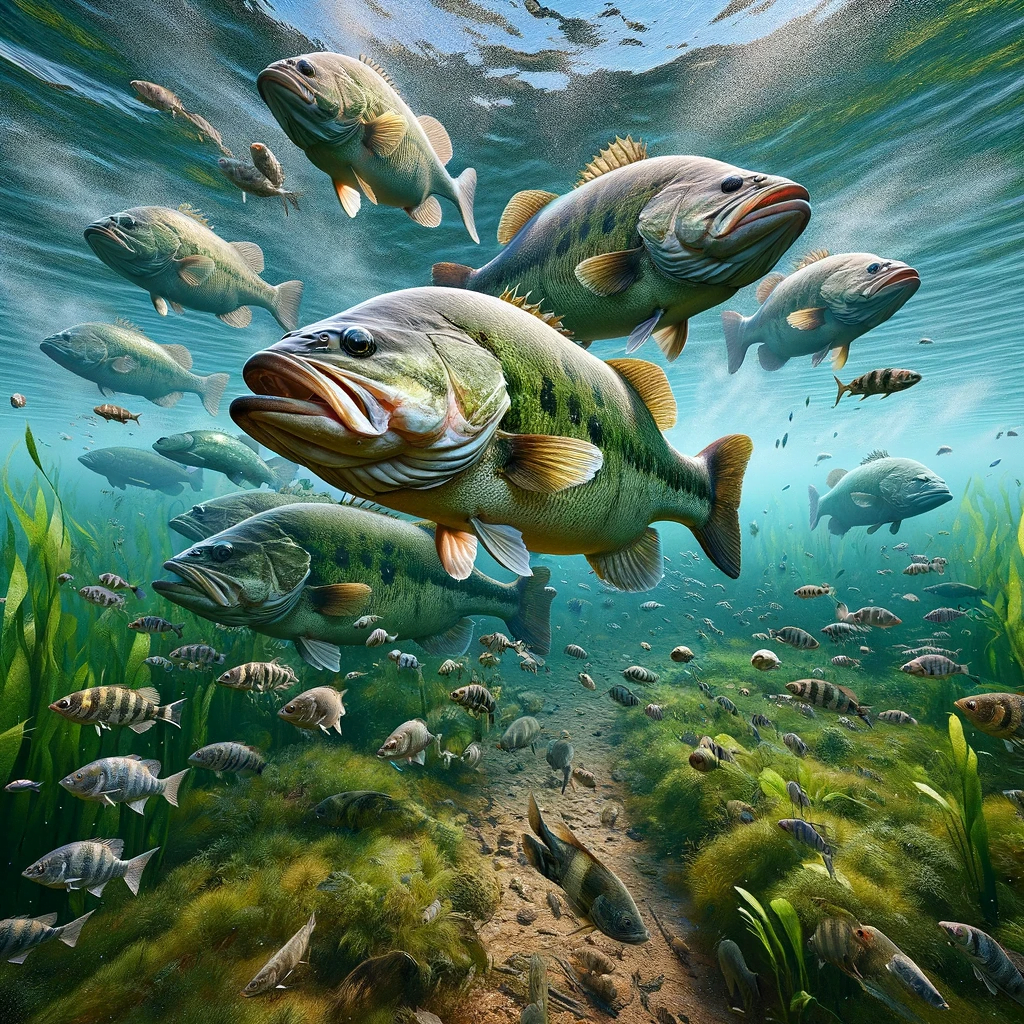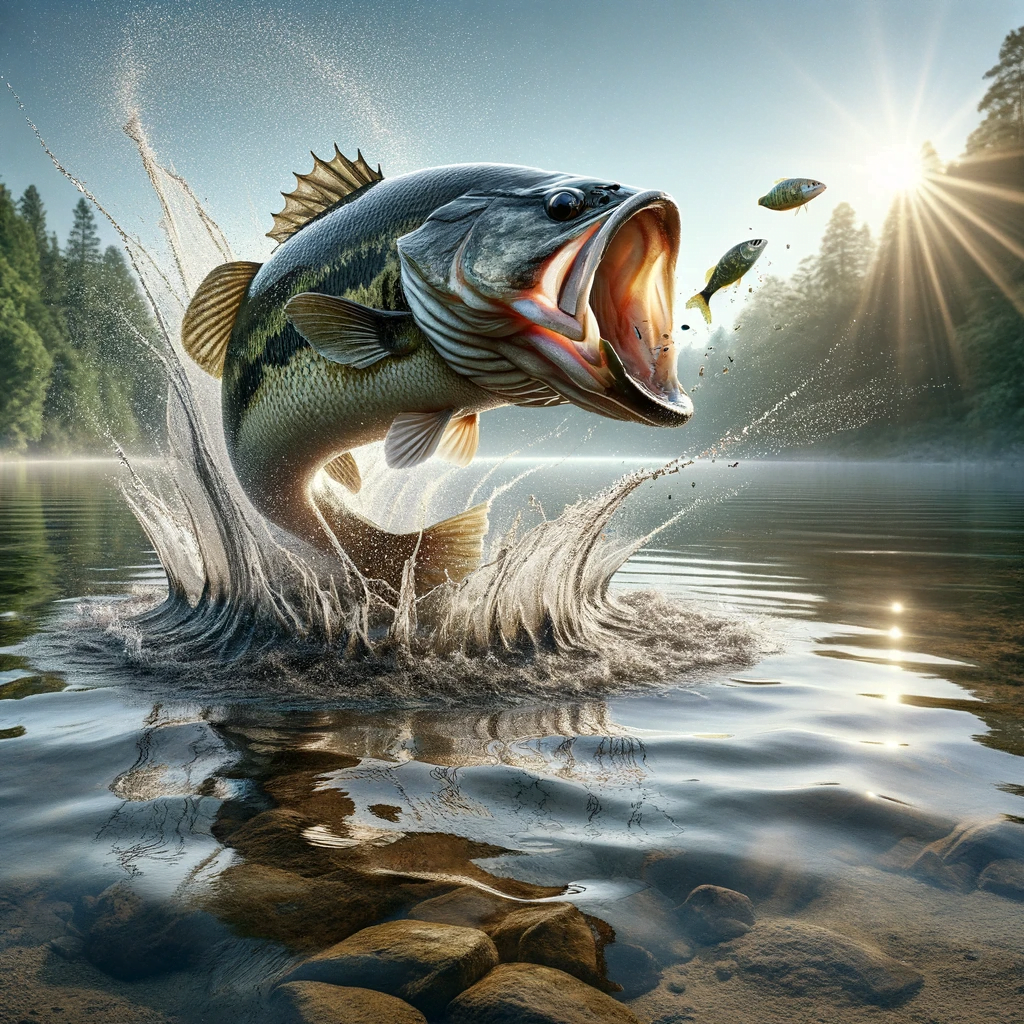Introduction
Cannibalism, where individuals eat others of the same species, occurs in many types of animals, including fish. Largemouth bass are ambush predators that will eat any potential prey they can capture and swallow. But do largemouth bass actually eat each other? Let´s answer the question Are Largemouth Bass Cannibals?
While not common behavior, there is evidence that largemouth bass can become cannibalistic under certain conditions. They have been documented preying on younger bass, eggs, and fry when facing issues like overpopulation, limited food supply, and significant size differences between adults and juveniles.

Evidence of Largemouth Bass Cannibalism
Several scientific studies have documented cannibalism in largemouth bass populations:
- A 1984 study showed largemouth bass predation accounted for up to 67% mortality of young-of-year largemouth bass in Lake Opinicon, Ontario.
- Researchers in Texas found that 60% of adult largemouth bass stomachs contained juveniles of their own species. Cannibalism was highest when prey fish populations were lowest.
- Largemouth bass introduced to new waters have also exhibited more cannibalistic tendencies as they establish themselves, such as those stocked in Lake Waccamaw, North Carolina.
- A 1958 study by Swingle and Smith found that when young largemouth bass were confined in ponds with larger adults, loss rates were significantly higher, suggesting cannibalism.
- Multiple studies in experimental hatchery ponds have found survival rates of fry raised with adults to be extremely low, often 0%.
In addition to scientific data, many anglers have witnessed or caught adult largemouth with partially digested juvenile bass in their stomachs. Bass tournament organizations even implement size limits to discourage targeting spawning adults that are more likely to cannibalize.
There are also many eyewitness accounts shared on fishing forums and websites describing firsthand observations of largemouth bass cannibalism:
“I watched a 5lb bass suck in a 1lb bass in a farm pond. He didn’t just nip it, he full on ate it.”
“Caught a 6 pounder once with a 2 inch bass hanging out its mouth. He got one free meal but ended up my dinner instead!”
“While fishing a small lake in Missouri last summer, I had a bass swipe my plastic worm right off the hook. When I reeled him in, I could see the tail of another smaller bass sticking out of his throat.”
While anecdotal, these angler observations support the scientific evidence that cannibalism does occur in bass populations.
Reasons Largemouth Bass Become Cannibalistic
There are several reasons why largemouth bass might resort to cannibalism under certain conditions:
- Hunger – When prey fish like shad, sunfish, and shiners are scarce, bass may turn to eating younger members of their own species to survive. This opportunistic feeding behavior allows them to take advantage of any nutrition source they can capture.
- Size disparity – Smaller juvenile bass are much easier targets for substantially larger adult bass. The adults are able to swallow the juveniles whole with their large mouths and expandable stomachs. A 6-8 inch fingerling is an easy meal for a 2+ pound adult.
- High population density – In waters with an imbalance favoring high densities of bass versus limited prey, cannibalism is more likely to regulate the overloaded predator population. When too many bass compete for too few shad and sunfish, they may turn on their own young.
- Spawning aggression – Adult bass guarding nests will attack and eat any potential threat during spawning season, including juvenile bass encroaching on their territory. Protecting the nest becomes the top priority, even above species identification of intruders.
- Opportunistic feeding – Bass instinctively feed on whatever prey items they can capture and swallow. Juvenile bass, eggs, and fry make for easy opportunities when they are abundant. Any movement triggers a predatory reaction.
- Establishing dominance – In lakes and ponds with limited structure and feeding territories, the more aggressive adult bass may cannibalize smaller individuals to establish dominance hierarchies.
- Taste preference – Some studies indicate that once bass start feeding on their own young, they can develop a “taste” for them and continue seeking them out preferentially as a food source.
Conditions Promoting Cannibalism in Bass
Certain environmental and population factors can increase cannibalism rates among largemouth bass:
- Overharvesting of prey species while leaving bass unmanaged
- Introduction of largemouth bass into waters with limited prey fish
- Insufficient habitat for young bass to hide and escape from adults
- Artificial conditions like small hatchery ponds at high densities
- Loss of shoreline vegetation that serves as refuge for fry
- Spawning-related aggression and lack of nesting sites
- Low water levels concentrating fish populations
- Unbalanced sex ratios skewing towards more dominant males
- High variability in year class strengths magnifying size disparities
- Poor water quality stressing bass and triggering aggressive behavior
Additionally, seasonal factors can promote cannibalism:
- Late spring when adults are guarding nests and fry are emerging
- Hot summer months when metabolism is high but prey is scarce
- Cold winters when bass are lethargic and fry are weak
Ways to Reduce Largemouth Bass Cannibalism
Fisheries managers have tools to prevent or reduce cannibalism in lakes and ponds:
- Stocking adequate prey species like bluegill, shad, and shiners to provide alternate food sources
- Promoting aquatic vegetation growth to provide cover for young bass to hide
- Implementing harvest regulations to maintain a balanced bass density matched to prey
- Separating adult bass from juveniles and eggs in hatchery ponds during spawning
- Providing supplemental feeding to juvenile bass in hatcheries when adults are present
- Adding structure like submerged logs or rock piles, which provide additional ambush sites and territories to disperse competitive interactions
- Using catch-and-release regulations for largemouth bass to retain large males who help guard fry from cannibals
- Setting larger minimum size limits for harvested bass to protect spawning adults
- Manipulating water levels to stimulate prey fish spawns before largemouth bass begin nesting
Impacts and Considerations of Cannibalism in Bass
The occurrence of cannibalism can have several implications for bass populations and fishing:
- It disrupts predator-prey balance and can lead to stunted growth and less large bass
- Removing large, dominant males through angling reduces protection of juveniles and may increase cannibalism
- Bass may develop a “taste” for their own young and continue seeking out juveniles preferentially
- Cannibalism in hatcheries can completely eliminate fingerling batches and waste resources
- May damage reputation of bass among anglers as “trash fish” or “self-destructive”
- Can complicate stocking efforts if adult bass are present and consume introduced fingerlings
- Loss of year classes to cannibalism can create gaps in size distribution
- May increase incidence of parasites and disease transmission from eating infected juveniles
- Further stunts growth of cannibal adults by wasting energy on low-nutrition juvenile bass
More research is still needed on specific conditions that promote cannibalism versus normal predation in bass to better guide management strategies. But generally maintaining bass in balance with adequate prey species can help reduce instances of bass feeding on their own young.

Examples of Largemouth Bass Cannibalism
- At Lake Sammamish in Washington state, researchers found that introductions of adult largemouth bass led to cannibalism on stocked fingerlings. Almost no juvenile bass survived the first year until stocking practices were changed.
- In Lake Sugema, Iowa, biologists discovered that cannibalism from largemouth bass was limiting recruitment of crappie. Implementing a 12-inch minimum size limit helped reduce cannibalism of juvenile crappie substantially by protecting the adult bass.
- At the Codorus Creek reservoir in Pennsylvania, electrofishing surveys showed weaker year classes of largemouth bass despite adequate spawning. Analysis of stomach contents revealed significant cannibalism on fry, indicating lack of habitat was forcing adults and juveniles to overlap.
- In Texas, water levels dropped rapidly in Lake Alan Henry during a drought in the 2000s. With limited habitat, bass experienced crowding and densities increased. Biologists documented increased cannibalism and even adult bass mortality from being eaten by larger fish.
- At Lake Sammamish, an analysis found that years with poor springtime sunfish hatches resulted in higher bass cannibalism rates in summer. Stocking additional bluegill helped provide an alternate prey source.
Preventing Cannibalism in Hatchery Ponds
Fish hatcheries take special precautions to avoid largemouth bass cannibalism when raising fingerlings:
- Separate adult bass from eggs and fry to avoid predation
- Start fingerlings in hatchery troughs before transferring to ponds
- Provide supplemental feeding of minnows or pelleted food to divert from eating each other
- Increase structure and cover for fingerlings to hide from adults
- Ensure balanced prey populations with bluegill or fathead minnows
- Carefully size grade fingerlings during transfers to avoid large size disparities
- Monitor survival rates and stomach contents to check for cannibalism
- Remove any adult bass showing tendency to prey on juveniles
- Maintain proper densities in rearing ponds to avoid crowding stress
- Produce more fingerlings than needed to account for potential losses to cannibalism
- Consider temporary barriers in ponds with small mesh enclosures to protect areas for fingerlings
With close management, hatcheries can minimize cannibalism and ensure maximum survival rates of stocked bass fingerlings.
Conclusion
While cannibalism among largemouth bass does occur in some populations and conditions, it is not an inherent or common behavior universally. Provided adequate food sources, vegetation, spawning sites, and balanced densities with prey, cannibalism seems to be minimized in most fisheries. The majority of bass naturally feed on the most abundant prey sources like shad, bluegill, and crawfish.
However, biologists must remain cognizant of the conditions that can promote cannibalism – low prey abundance, limited habitat, spawning stress, overcrowding, size variability, etc. By managing bass populations holistically within a balanced fish community and ecosystem, occurrences of cannibalism can likely be reduced or prevented.
With proper habitat and prey availability, along with regulated harvest, largemouth bass do not need to resort to eating their own young to survive. While opportunistic generalists, they are not inherently cannibals in all circumstances. More ecosystem-based research is still needed to refine management practices that discourage cannibalism and promote sustainable bass fisheries.
References
Allen, M.S. and Miranda, L.E. “A Qualitative Evaluation of Special Regulations for Largemouth Bass Management in Florida.” North American Journal of Fisheries Management. 19 (1999): 552-563.
Parkos III, J.J. and Wahl, David H. “Intracohort Cannibalism and Associated Mortality of Larval Largemouth Bass in Relation to Initial Stock Density.” Transactions of the American Fisheries Society. 131 (2002): 850-858.
Porak, W.F. et al. “Factors Affecting Survival of Largemouth Bass Fry in a Northern Florida Lake.” American Fisheries Society Symposium. 8 (1985): 81-87.
Rieger, P.W. and Summerfelt, R.C. “The Influence of Feeding Rate and Rearing Density on Growth, Survival, and Feed Conversion of Largemouth Bass Fry.” The Progressive Fish-Culturist. 40 (1978): 62-64.
Wahl, David H. and Stein, Roy A. “Selective Predation by Three Escocids: The Role of Prey Behavior and Morphology.” Transactions of the American Fisheries Society. 117 (1988): 142-151.




